The best child's bike seats are a great way to get kids out on a bike if they're not ready to learn to ride a bike themselves or just don't want to ride as far as you do, and a great introduction to family cycling.
When they are old enough to ride themselves, you can also check out our guide to the best kids' bikes.
The best bike seats for children are well designed by people who ride and have thought through the important details such as comfort, support for a young rider, secure harnesses and keeping feet and hands out of a spinning wheel's spokes.
Here's our pick of the best bike seats for children, followed by a buyer's guide on how to choose the best kids' bike seat.
Best bike seats for children
Thule RideAlong
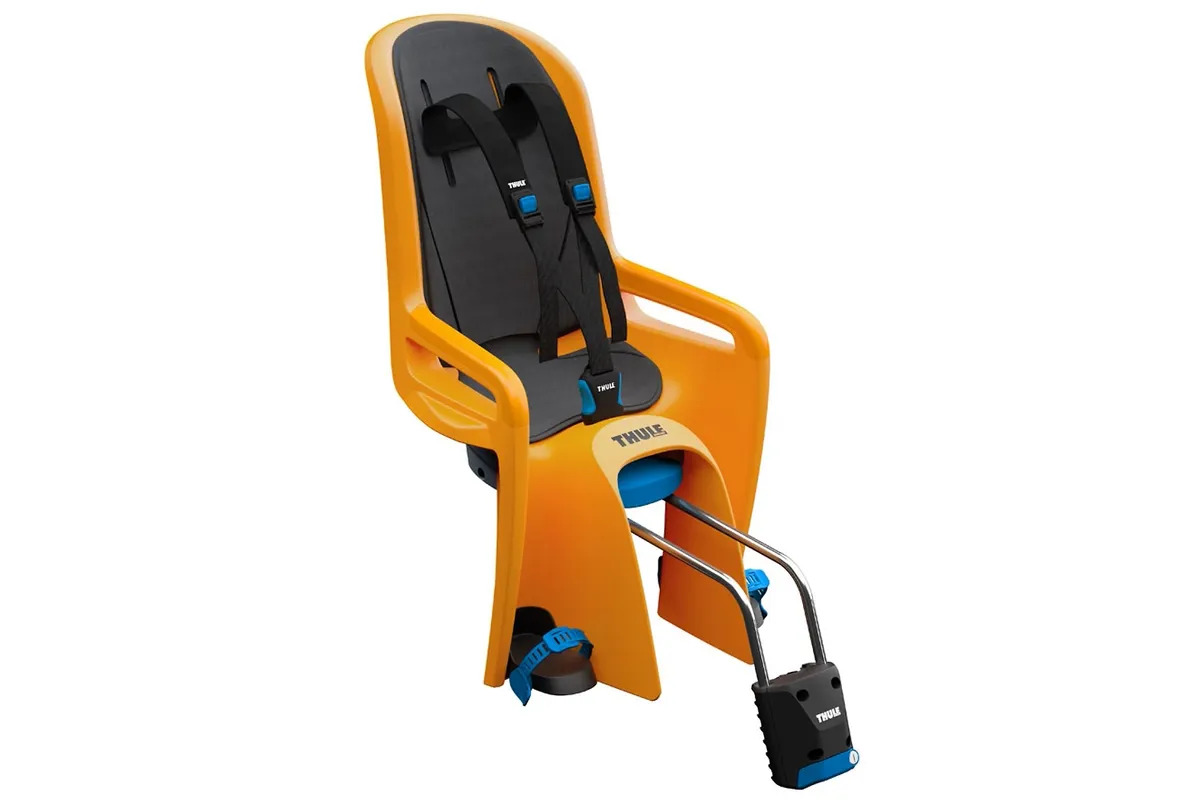
- £140 / $299.95 / €159.95 / AU$349
- Seat can be reclined through five positions
- Range of colour options
The Thule RideAlong has a seat suspended from a mount that clamps to the bike's seat tube. As such, there's a bit of suspension and the quick-release mechanism means the bike seat is easy to remove from the bike when not in use.
The RideAlong reclines through five positions with up to 20 degrees of lean-back, so a sleeping child won't loll forward in the three-point harness. It's rated for kids up to 22kg and comes in a range of colours.
Polisport Bubbly Maxi FF Child Seat
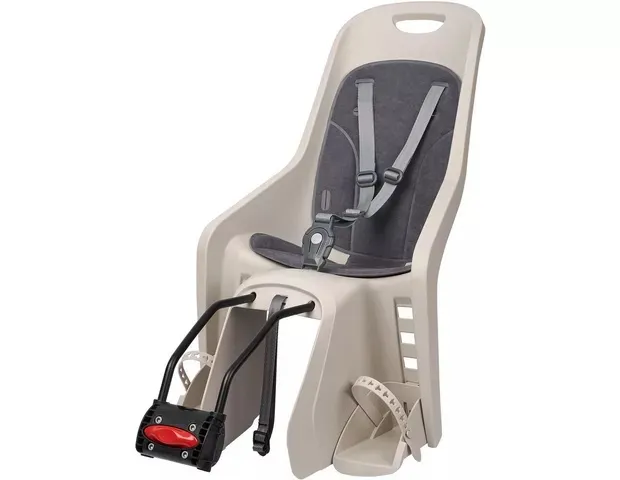
- £45
- Budget price
- Three positions for the seat to suit growing children
The Bubbly Maxi is a budget-priced down-tube mounted child seat that follows the same design as the Thule RideAlong and is suitable for kids up to 22kg.
There are adjustable footrests and height-adjustable anchors for the three-point harness. The seat can be moved back through three positions as your child grows.
The Bubbly Maxi is quick to remove from the bike when not in use, has a padded seat and is available in five different colours.
Hamax Kiss
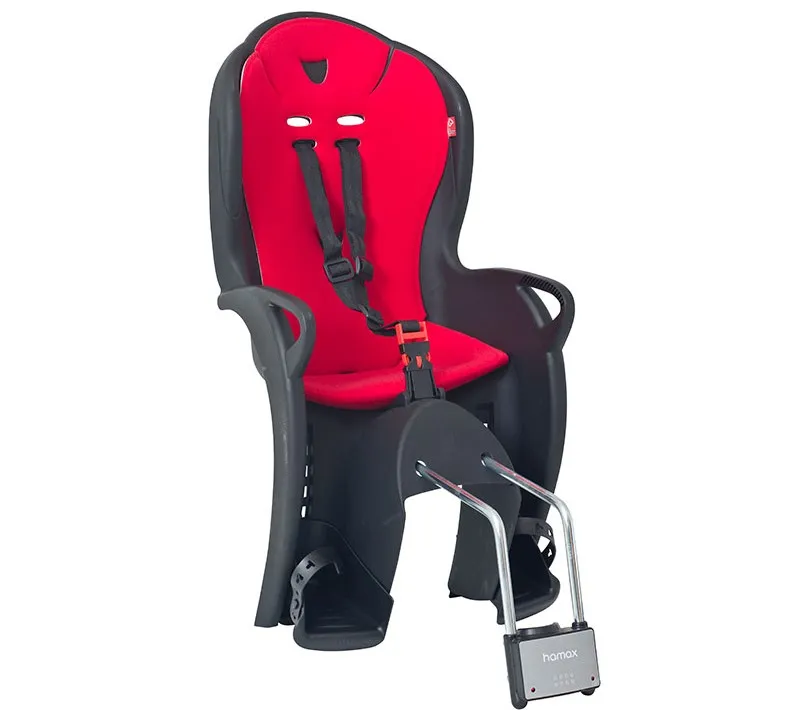
- £59.99 / €74.90
- Quick-release design cantilevered over the rear wheel
- Non-rigid support provides suspension for the seat
The Hamax Kiss is a straightforward rear-mounted child seat. It is supported by sprung rails that clamp to the bike's seat tube and jut out behind the bike.
The design gives some extra suspension for the seat and is easy to remove from the clamp when not in use.
Hamax says the Kiss can be used for children as young as nine months and until they weigh 22kg, so there's the potential for a long period of use.
The Kiss includes protectors to keep feet out of spokes and a recess to fit a helmet so that your child's head isn't pushed forward. There's removable padding and a rear reflective strip.
Hamax Zenith

- £79.99 / €94.90
- Fits to the majority of bike luggage racks
- Five-point harness and foot protectors
The Hamax Zenith child seat is one of a number of options that mount to a rack on the rear of the bike. It comes with an adaptor to fit most round-railed bike racks, with the rack needing to be rated to carry 25kg loads.
The Zenith has all the safety and comfort features of Hamax bike seats, such as a five-point anchor and footguards with straps. The high back has a recess for helmet comfort.
With a universal fitting to a standard bike rack, you can use the rack for other duties when not carrying kids and once they've grown out of their seat.
Bobike Exclusive Tour Plus
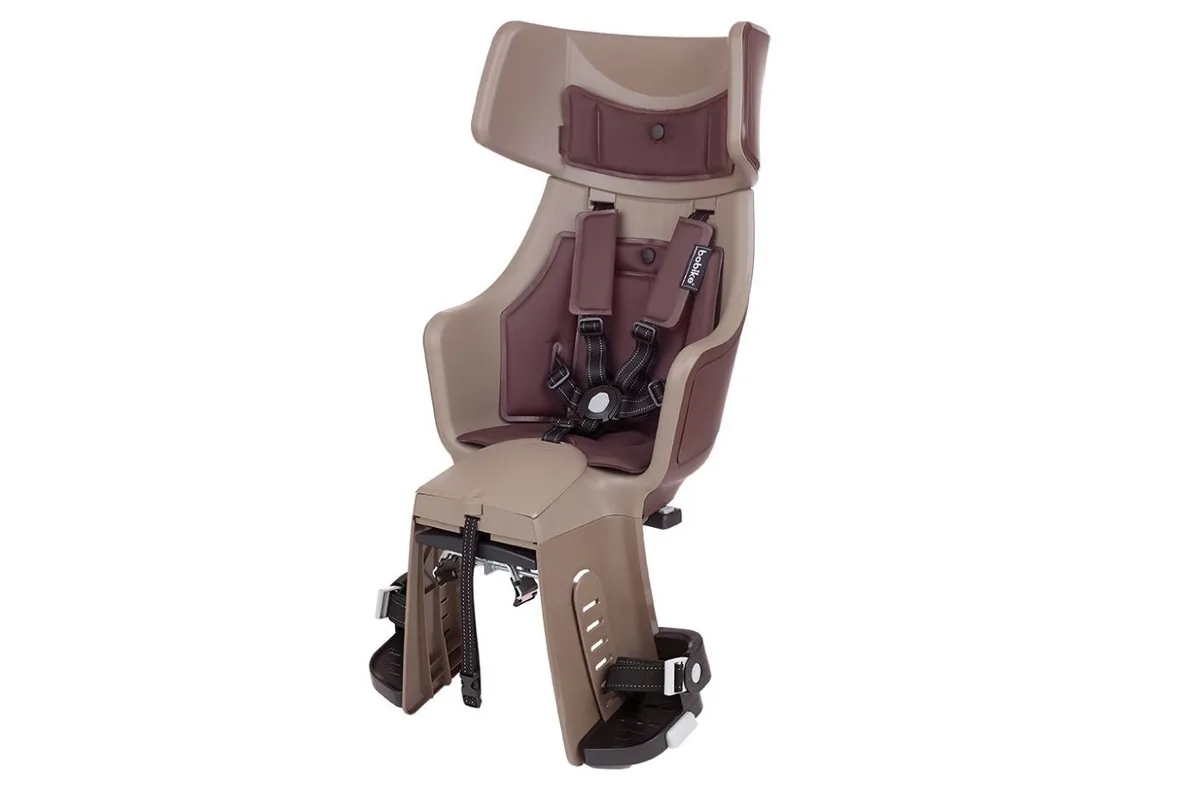
- £125 / $199
- Wrap-around design with adjustable headrest
- Includes LED rear safety light
The Bobike Exclusive Tour Plus comes with a wide, adjustable head restraint that wraps around a helmet to keep your kid's head secure. Bobike says it has given its design a make-over with more comfortable padded harness straps to the five-point seatbelt.
It's suitable for kids from 9kg up to 22kg, comes with a rear carrier quick mount and includes a rear LED safety light. The footrests are adjustable for growing kids and it's available in six colours.
Thule Yepp Nexxt Maxi
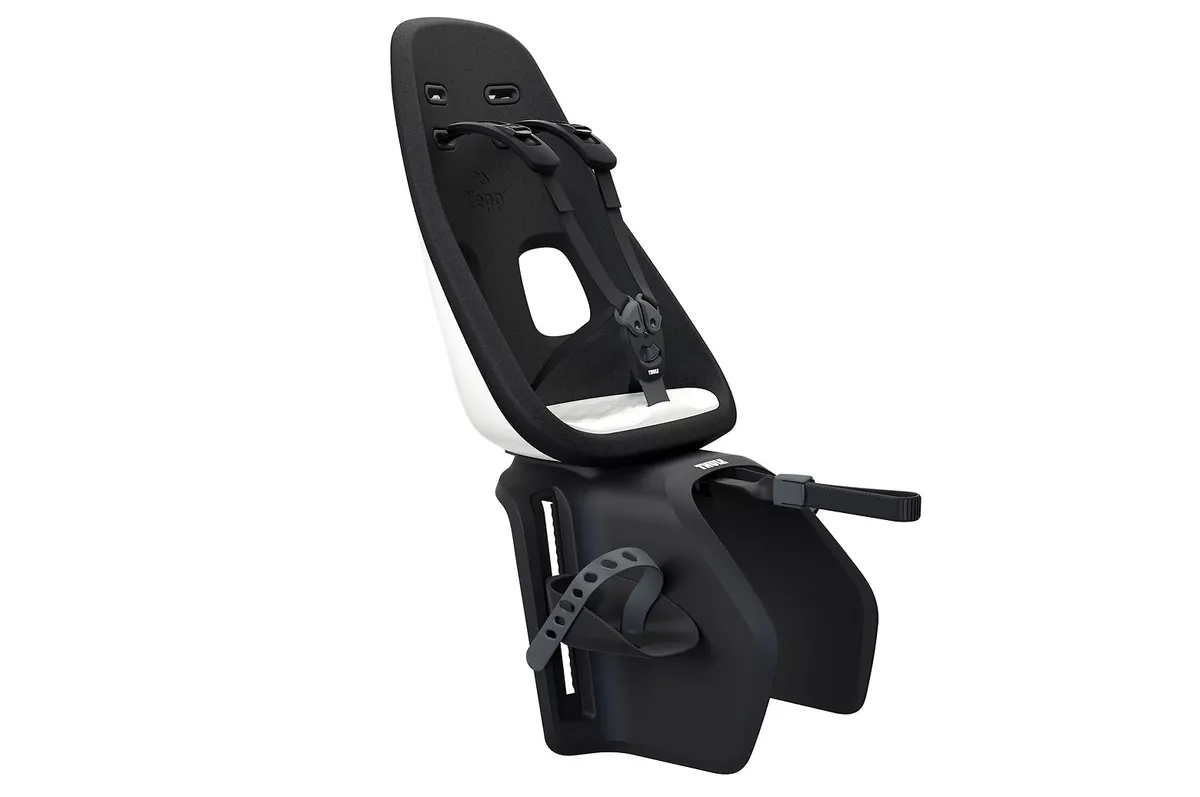
- £130 / $299.95 / €169.95 / ¢399
- Fits to a range of bike racks with an adapter
- Includes a rear-light mounting point
The Yepp Maxi is another child seat that mounts with an adaptor to a rear rack, so it's easy to take on and off. The footrests and straps are adjustable, so you can continue to use the child seat as they grow.
There's a five-point harness and shock absorption built in, as well as wipe-clean padding. Thule includes a mounting point on the rear for a bike light to up your visibility.
Hamax Caress Observer
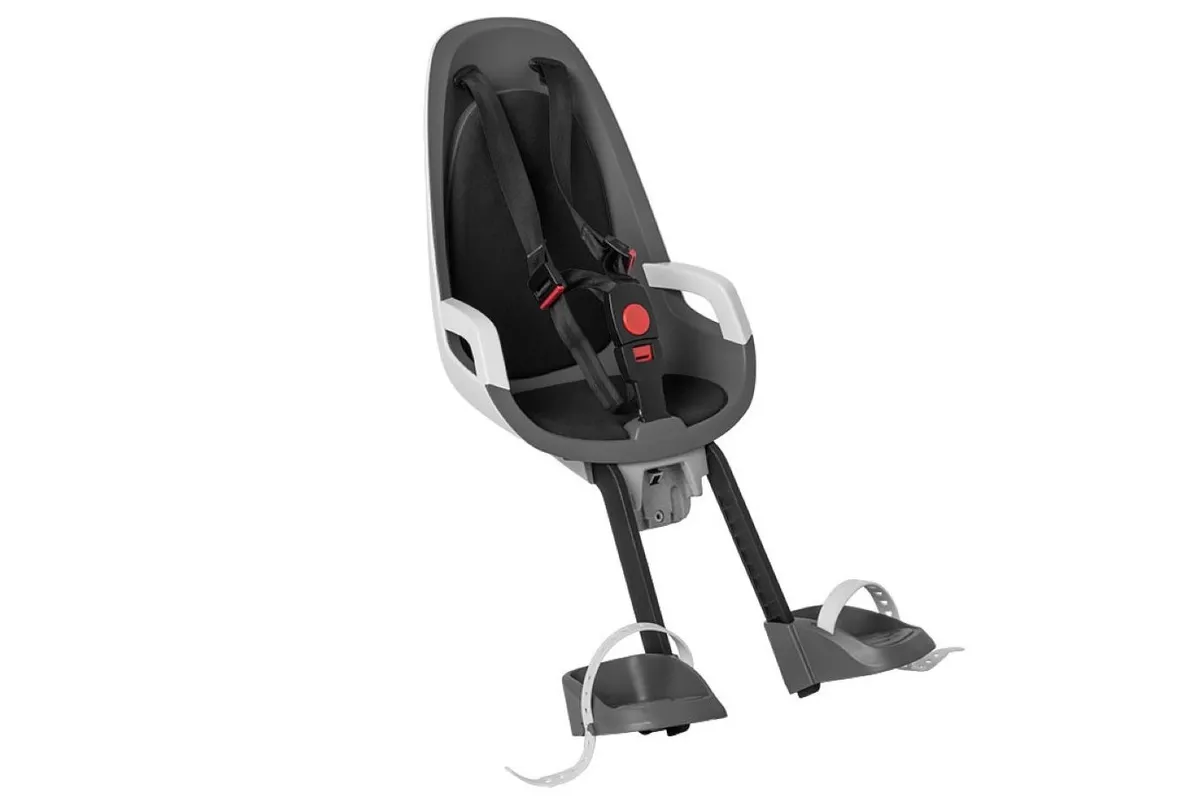
- £89.99 / / $149 / €89.90
- Mounts to the bike's steerer
- Optional windshield for extra weather protection
The Hamax Caress Observer bike seat is a front-mounted design that fits to the bike's steerer tube with a quick-release bracket. It puts your child well forward on the bike so the seat is less likely to interfere with pedalling. It's rated for kids from 9 months up to 15kg weight.
The front mounting means your child sees the road ahead, not just your back. You can buy a windshield to add a bit of extra comfort and protection from wind, rain and flying insects.
Thule Yepp Nexxt Mini
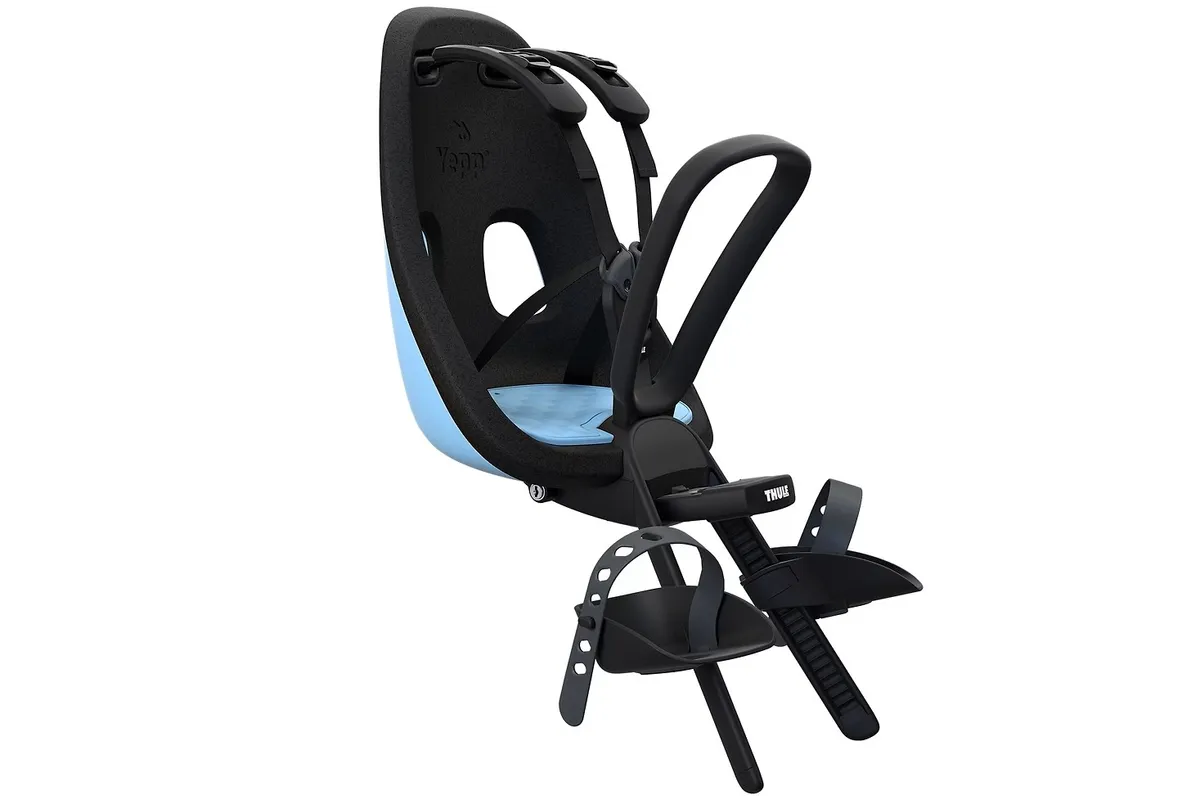
- £115 / $219.95 / €129.93 / AU$329
- Front mounted on the stem
- High, forward position keeps hands and feet out of the bike's mechanicals
The Thule Yapp Nexxt Mini is front-mounting with the seat positioned high and forward on the handlebars, giving kids a great view of the road ahead and keeping their feet away from the front wheel. There's a quick-release bracket and a handle for the child to hold.
Thule says the design will work for kids from 9 months up to three years old, with a 15kg weight limit. As with the Hamax Observer, you can add a windshield.
Bobike Go Mini
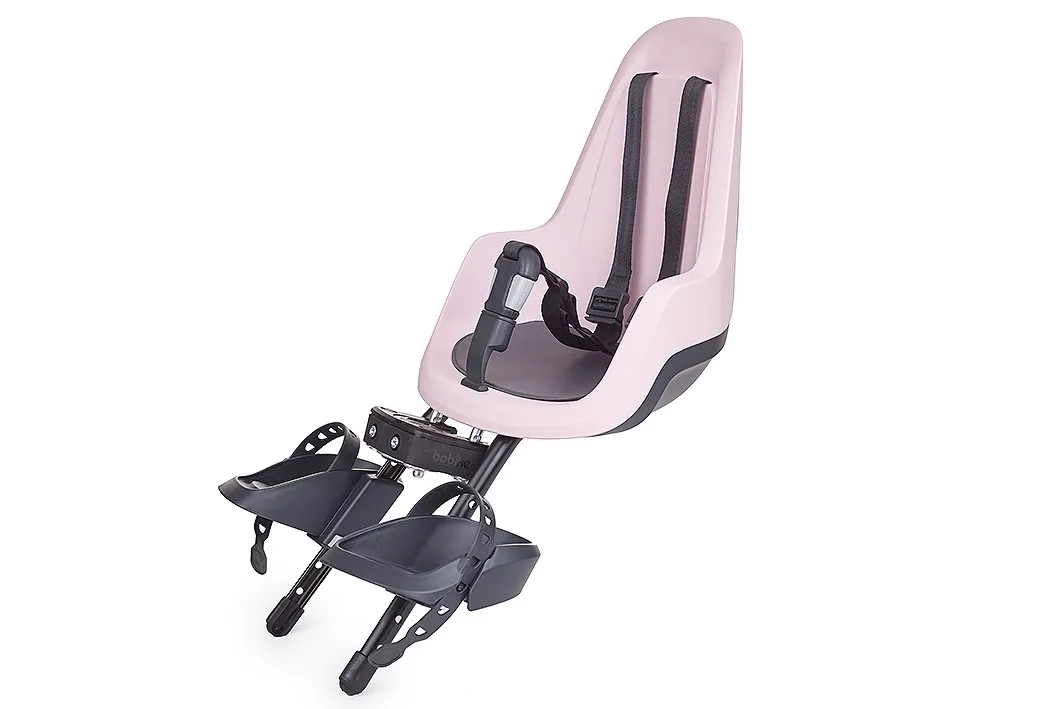
- £59.99 / €69.95
- Front-mounted child seat with armrests
- For kids up to 15kg
The Bobike Go Mini is another front-mounted child seat. It has a double-walled seat that wraps around the child for protection and includes armrests.
You can adjust the footrest position and there's a central buckle for the three-point harness that's designed to be operated with one hand.
It's available in a range of pastel colours, mounts to different-size head tubes and can carry kids up to 15kg. There's a windshield available as an optional extra.
WeeRide Safe Front Bike Seat
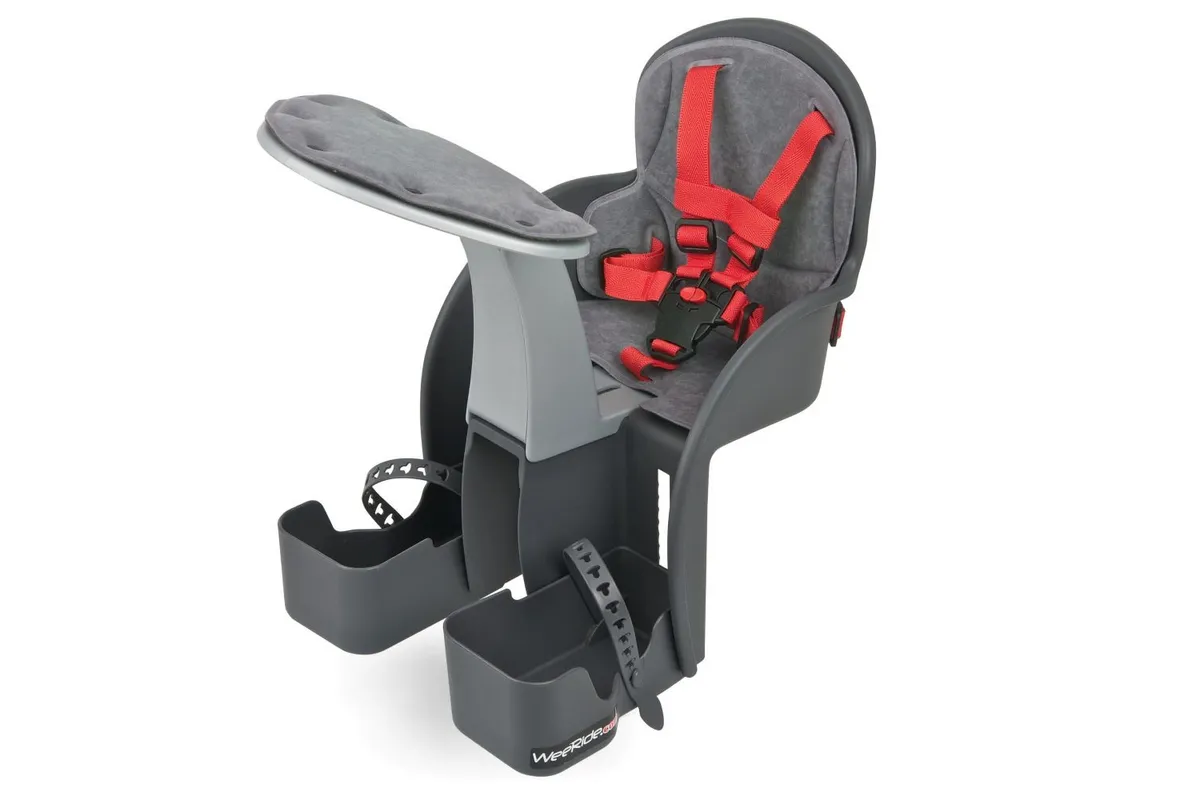
- £109
- Mounts over the bike's top tube
- Adjustable foot baskets
Rather than mounting to the head tube, the WeeRide Safe Front Bike seat mounts over the top tube. WeeRide believes this is safer than alternative steerer mount options.
WeeRide says the seat will fit kids up to four years old. The adjustable foot baskets avoid legs dangling and WeeRide says its design works well for mountain bikes.
The child seat rests on a carrier bar rather than the top tube and it can be removed quickly when you decide to leave your little one at home.
Polisport Bubbly Mini Plus FF Child Seat
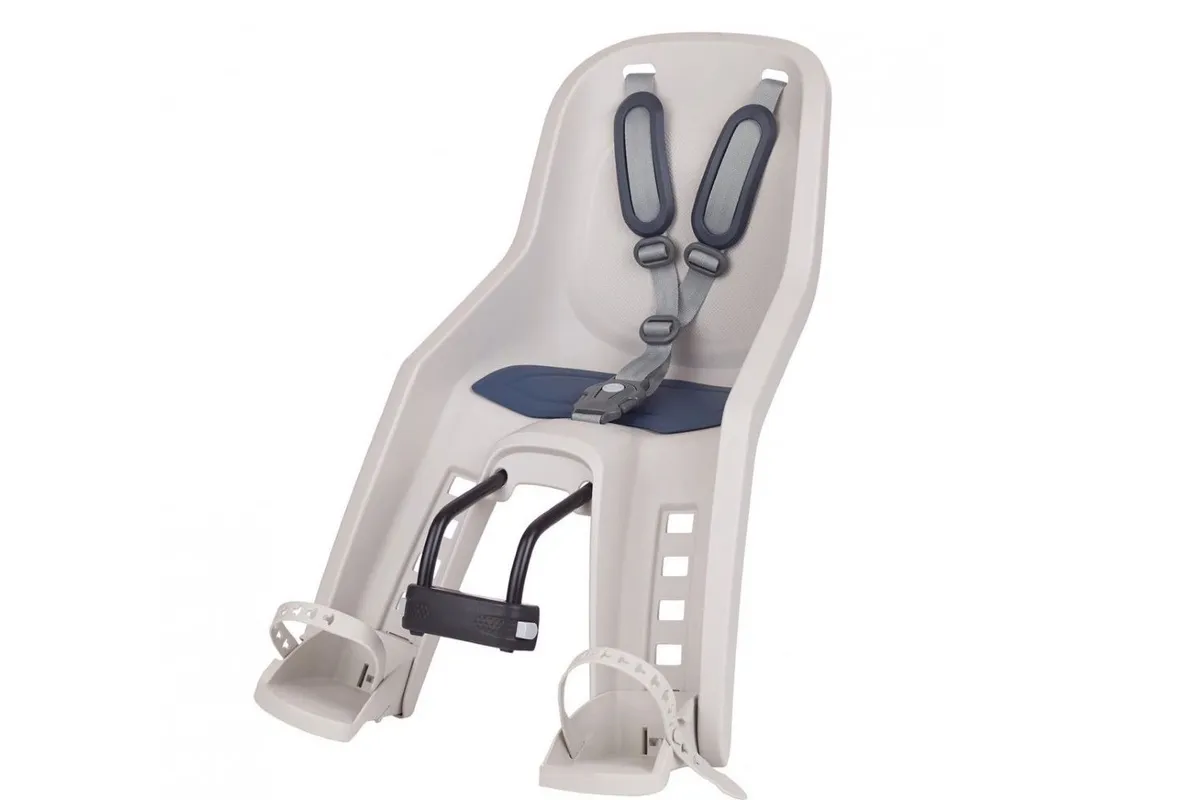
- £50
- Out-front seat but attaches to down tube
- 15kg weight limit
The Polisport Bubbly Mini Plus FF is designed for front mounting. Rather than fixing to the steerer tube, this Polisport bike seat is attached to the rear of the frame with a click-in mount in the middle of the down tube, like those for many rear-mounted child seat designs. This leaves the steering unimpeded, so it's a good option if you don't have a standard steerer or a step-through bike frame.
As with the majority of children's bike seats for front mounting, there's a 15kg weight limit, plus you get adjustable footrests and an adjustable three-point harness. You can add an optional windshield and a rain cover.
Buyer’s guide to child bike seats
At what age can a child go in a child bike seat?
Child bike seats are available for children from as young as nine months. For children that young, a seat with a reclined position will give a more comfortable position than one in which they sit upright. Seats with reclined positions also help ensure children are safer and less likely to flop forward if they fall asleep during a ride.
Most child bike seats will have a weight limit. Often it’s 22kg, which means your kids can use the seat until they’re about four. With the extra weight perched up high and, in the case of a rear seat, behind the rear wheel axis, bike handling can get tricky with older, heavier children, particularly when you’re strapping them in.
Rear-fitting child bike seat designs
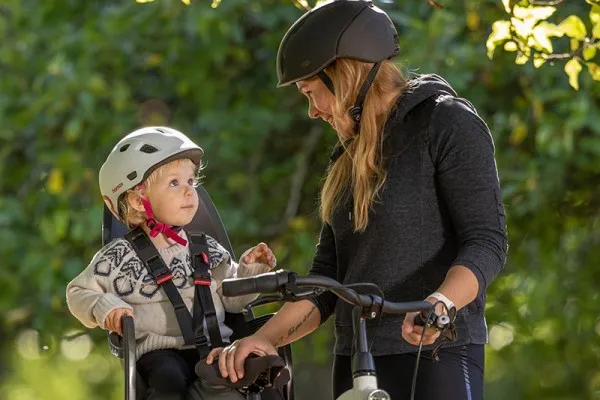
Rear-fitting child seats come in one of three basic designs. Some fit to your bike’s down tube and support the seat body on a metal frame that hangs out above the rear wheel.
Other seats clip onto a rear rack with an adaptor. This is a more rigid design and also means the rack can be used for other duties when the seat isn’t in use.
The third option is a seat with its own mounting points that attach to the seatstays or seatpost, sometimes with a quick-release system to remove the seat when not in use.
Front-mounted child bike seats
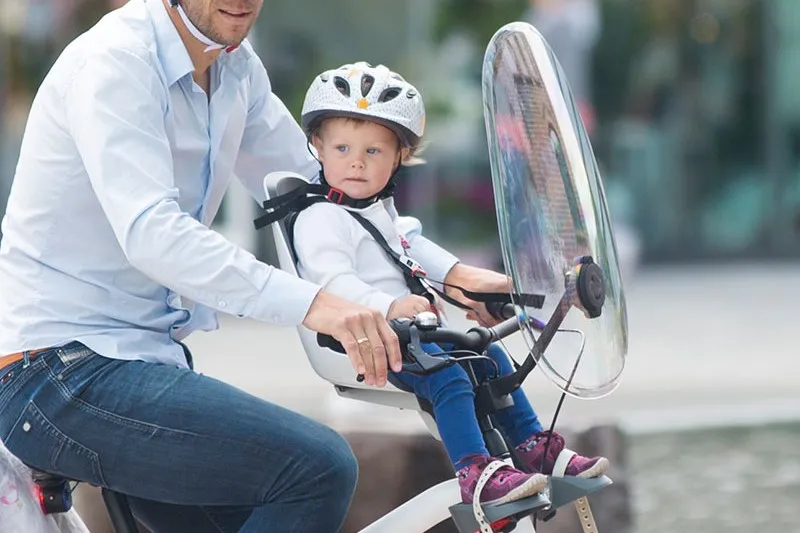
Some front-mounted child seats fit over the bike’s crossbar, others are fitted to the bike’s handlebars. Having the weight central on the bike can make it more stable than a rear seat, where the child’s weight may be behind the rear-wheel axis, although it can make steering more difficult.
With a front-mounted seat, your child gets a view of the road ahead, rather than your back, but they also get the full force of the wind as you ride, so a windshield is an optional extra from most makers.
Unlike a rear seat, if you do have a crash, you’re likely to be thrown into the child. As with a rear seat, keeping your child’s fingers and feet out of the wheel is important too, so the seat is often mounted high up.
Child bike seat safety

Child bike seats will come with a harness to keep your child securely fastened in place. It’s important to use the harness and to ensure it’s fitted correctly without too much slack. A five-point harness waist strap will help keep your child more secure than a three-point design if their shoulders slip out of a harness.
You’ll usually get foot straps or wells to stop a child’s feet, shoe laces or clothing from getting caught in the wheels (or kicking you as you ride).
As with adult riders, a helmet is highly recommended. The best kids’ bike helmets will fit comfortably and securely, and will protect them if you do have an accident while out riding.
Getting used to wearing a helmet will serve them well when they start riding themselves, too. Since a helmet is heavy, make sure their head is well supported and the angle of the seat is such that, if they fall asleep, their head will loll back rather than forward or to the side. A neck pillow designed for use with a car seat can help.
How to keep kids comfortable in a child seat
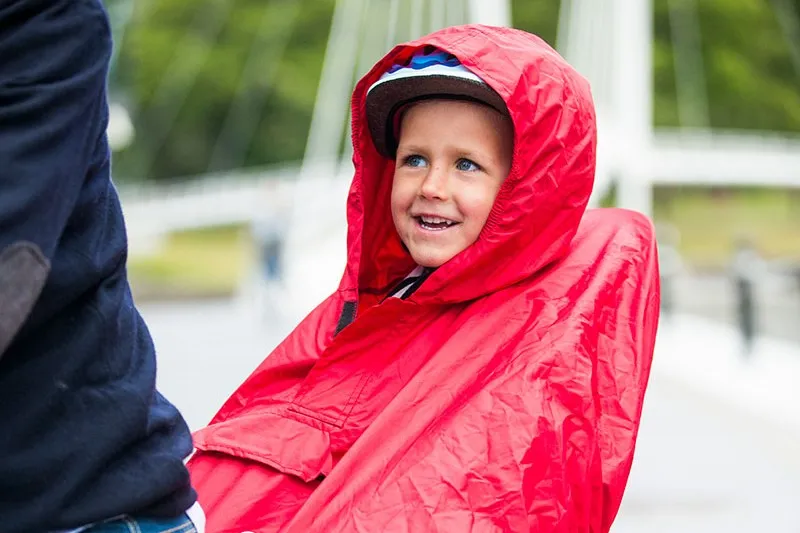
The main thing that will keep a child more comfortable in their seat is some windproofing and weatherproofing. You can buy ponchos to fit them and enclose the seat, keeping them more comfortable. You can also get a rain cover for most seats, so they don't have to sit in a puddle if you're picking them up from school.
Mudguards are a handy addition to stop your child from being sprayed with water from the wheels. Side protection from the wheels may be necessary to prevent your child from accidentally getting a hand or foot in them when riding, although most kids' bike seats are designed to help prevent this from happening.
Keep an eye on the weather conditions when you're riding. You may not feel the cold as you’re pedalling, but an inactive passenger in cold wind or rain needs to be wrapped up and protected. Conversely, in the summer be careful of overheating and make sure your passenger is protected from sunburn and properly hydrated.
Which bikes can I use a kids' bike seat with?
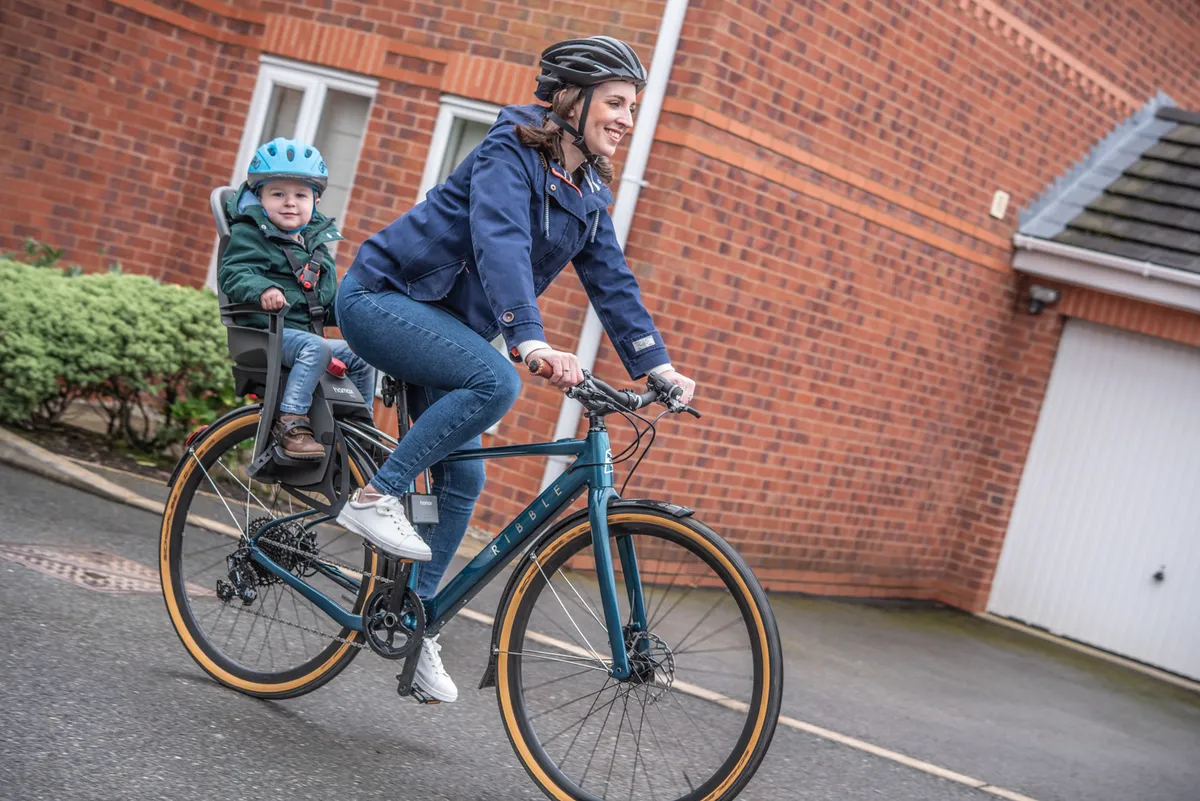
Bike seats for children can put a lot of extra stress on a bike's frame. The seats are not light themselves and adding a 20kg child to the load, which is held somewhere that a bike frame isn't designed for, could cause a problem for a performance bike – we wouldn't recommend bolting a child seat to your best road bike.
Many child seat designs can't be used with a carbon frame. A step-through frame may not have the rigidity to handle the extra weight and you may not be able to use a front-mounted seat with it.
An aluminium road bike might work, but a hybrid bike is likely to be a better option. A hardtail mountain bike is also a possibility, although the sprung rear triangle of a full-suspension mountain bike is likely to make a rear seat awkward to fit.
Other possible options are gravel bikes and touring bikes, which are designed to carry the extra weight of bike luggage, including pannier bags mounted on a rear rack and top tube bags. If you're concerned about the extra effort carrying your child and a seat will take, an electric bike is another option.
What are the alternatives to a child seat?
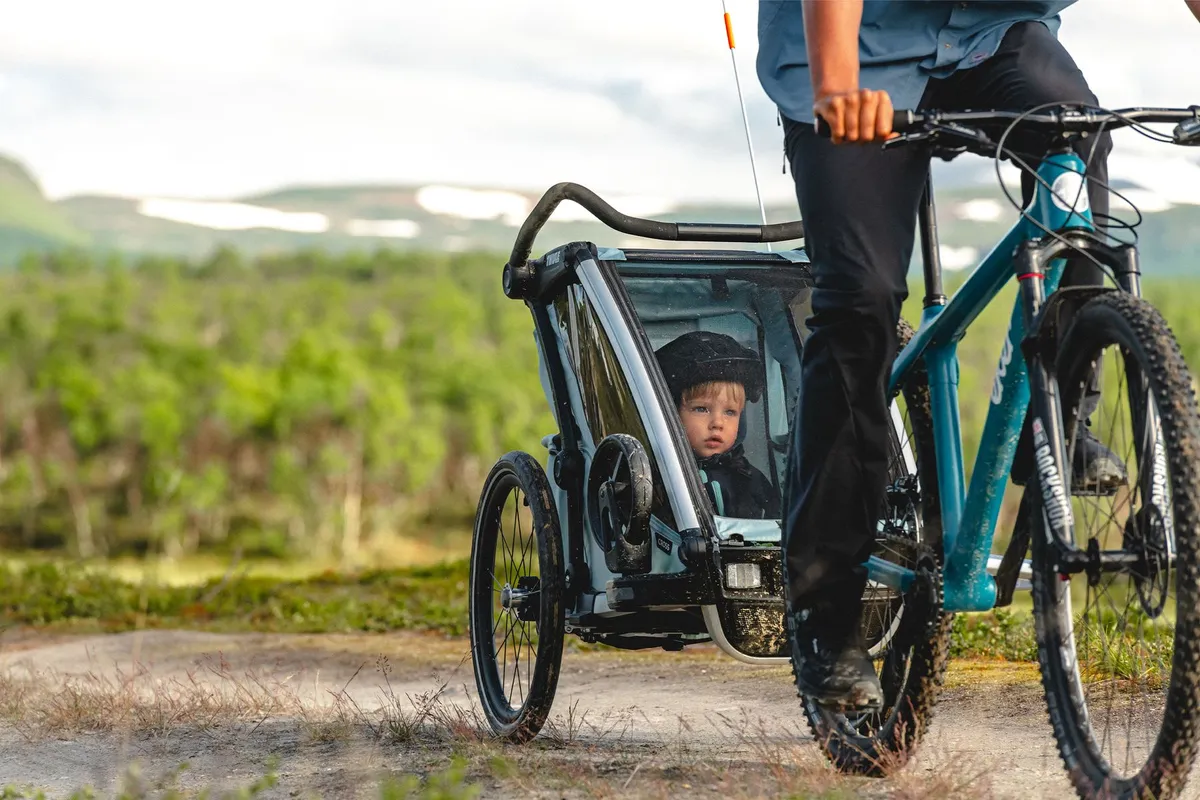
You don’t have to use a child seat to give your kid or kids a ride; particularly if you have more than one child to carry the alternatives may work better. You can potentially fit a front and rear seat to your bike to carry two kids, but balance may be an issue.
One option is to fit a bike trailer. Many of the best bike trailers come with space and seats for one or two kids, or you can buy seats to fit. That makes the trailer more versatile because it can be used for shopping and other activities too. It will have a life once your children have graduated to riding themselves. Usually, you can fit a hood to make the trailer weatherproof.
A trailer can also be detached easily when it’s not in use and for storage, although trailers are bulky items.
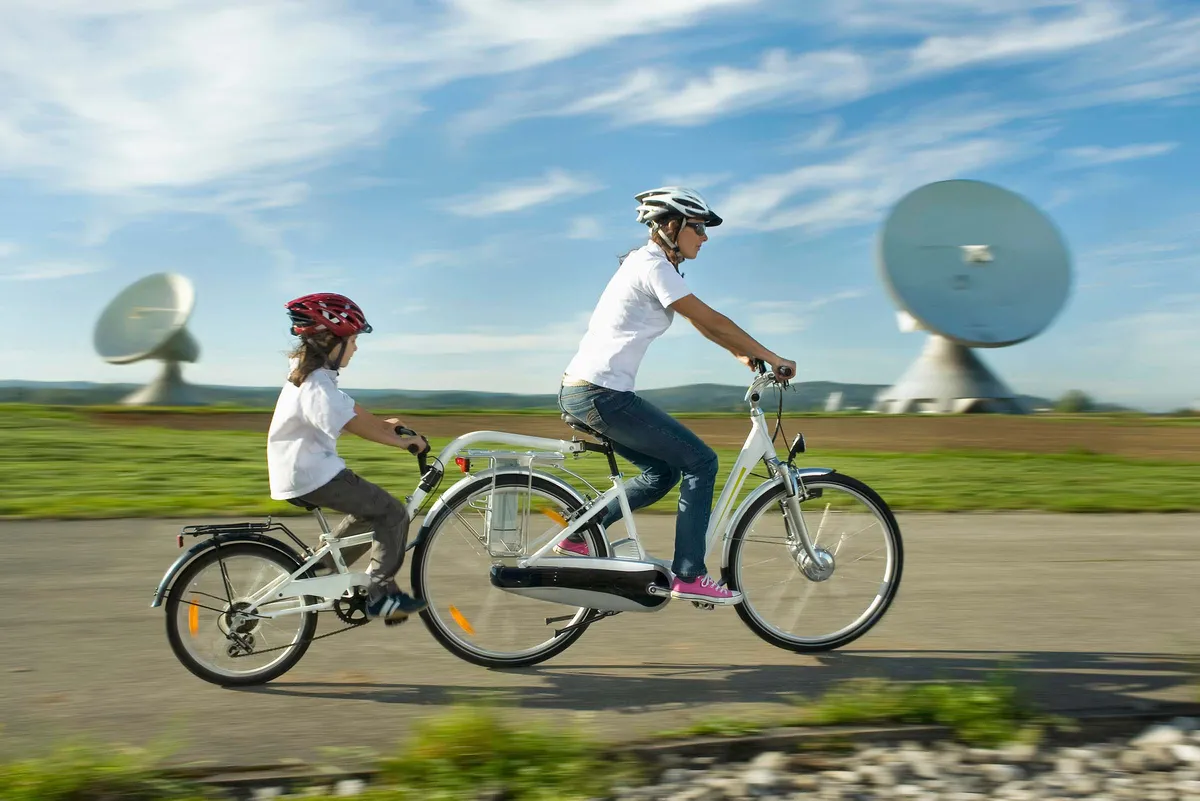
A second option is a tag-along, or trailer bike. It’s a cross between a child and trailer, with pedals and a non-turning handlebar that hooks to the back of your bike, enabling a child to pedal along with you on your ride. You may get a bit of assistance and they'll get some exercise.
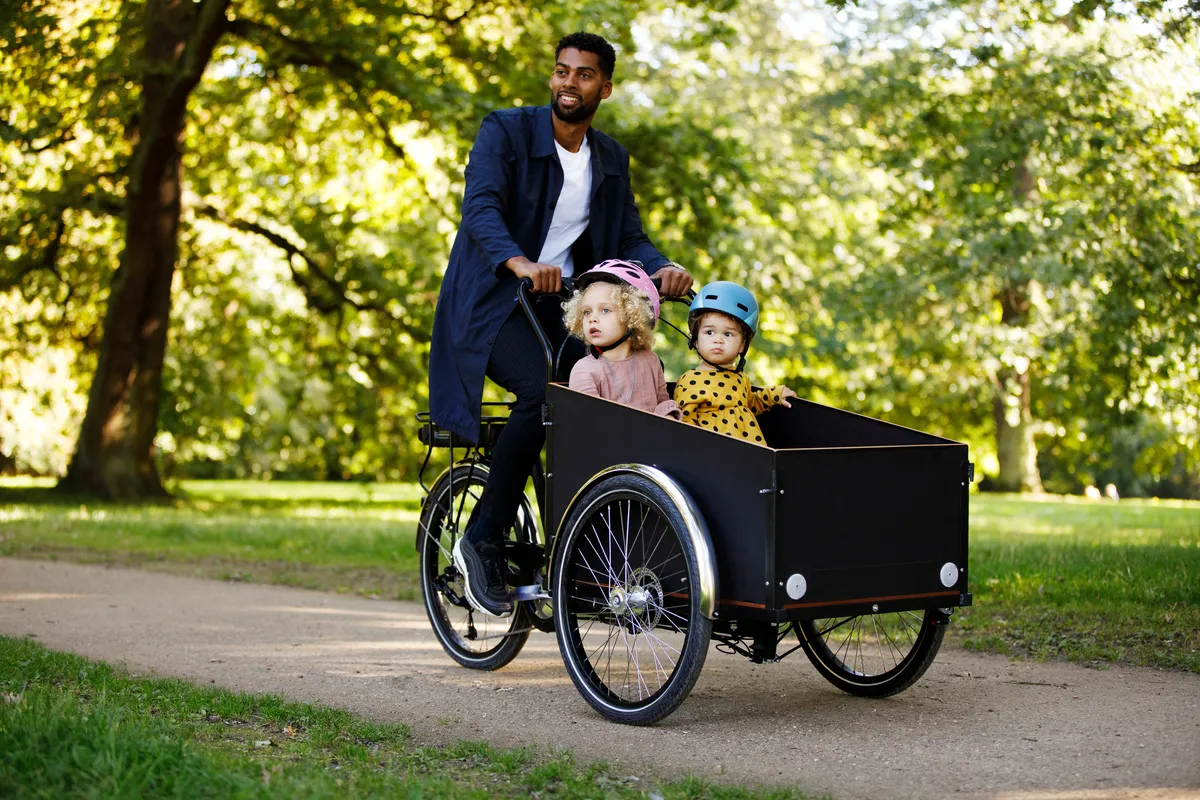
Another option is a cargo bike. Again, these can come set up with seats for children or you may be able to buy seats to fit in a standard cargo hopper.
Many cargo bikes will carry two children, either side by side or one behind the other and you may be able to fit a hood. An electric cargo bike is even better.
A cargo bike is a pricey option, though. It will be large and heavy, and you need to think about its life once the kids have grown out of it.
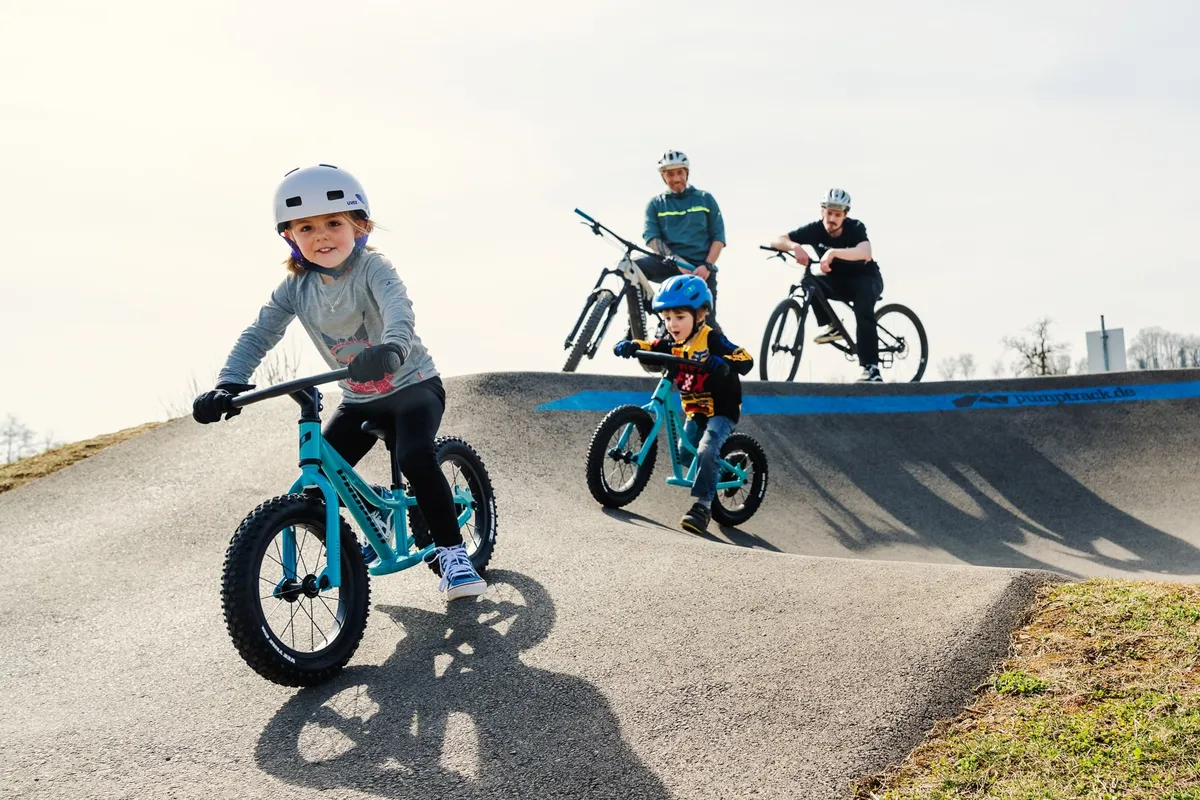
If your route is safe, letting them ride with you will give your kids some independence and extra exercise. Even quite small kids can get along surprisingly fast on the best balance bikes and older kids will likely want to ride themselves rather than being carried – at least for shorter distances.
There is also a wide range of adaptive bikes that can make cycling with disabled children easier, including pull-along trikes and carrier bikes.
Read our handy tips for commuting with kids for more ideas.
